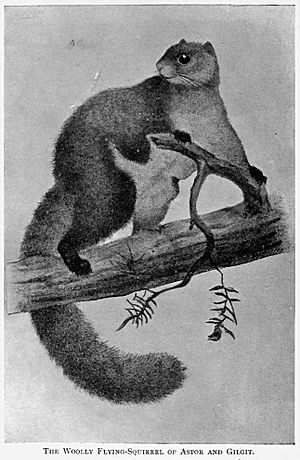Woolly Flying Squirrel facts for kids
Quick facts for kids Woolly Flying SquirrelTemporal range: Recent
|
|
|---|---|
 |
|
| Conservation status | |
| Scientific classification | |
| Kingdom: | |
| Phylum: | |
| Class: | |
| Order: | |
| Family: | |
| Tribe: | |
| Genus: |
Eupetaurus
Thomas, 1888
|
| Species: |
E. cinereus
|
| Binomial name | |
| Eupetaurus cinereus Thomas, 1888
|
|
The woolly flying squirrel (Eupetaurus cinereus) is a very special type of squirrel. It's the only known species in its group, called Eupetaurus. This amazing animal is one of the largest gliding animals in the world!
For a long time, scientists knew very little about this rare squirrel. They only had about 11 animal skins collected way back in the late 1800s. But thanks to recent studies, we now know that the woolly flying squirrel is still living in Pakistan-administered Kashmir.
Contents
What Makes This Squirrel Special?
The woolly flying squirrel is the longest member of the squirrel family, Sciuridae. It's also the heaviest animal known to glide. Even though it's big, observations show that it can glide through the air just like other smaller flying squirrels.
Where Do Woolly Flying Squirrels Live?
These squirrels are found in the high, rocky areas of the Himalayas. They prefer places with cliffs and pine forests. This helps them stay hidden and safe.
How Do They Glide?
Like other flying squirrels, the woolly flying squirrel has a special flap of skin. This skin stretches between its front and back legs. When it jumps from a high place, it spreads its legs. This makes the skin flap act like a parachute or a wing. It allows the squirrel to glide from tree to tree or from a cliff to a lower spot.
What Do They Eat?
Woolly flying squirrels are mostly plant-eaters. They likely eat pine cones, needles, and other plant parts found in their mountain homes. Scientists are still learning more about their exact diet.
Why Are They Important?
The woolly flying squirrel is considered an endangered species. This means there are not many of them left in the wild. Protecting these unique animals helps keep the natural balance in their mountain habitats. It also helps protect the amazing variety of life on Earth.
Scientists continue to study these shy creatures. Learning more about them helps us understand how to protect them and their homes.


